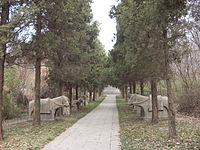Tomb of the King of Boni
| Tomb of the King of Boni | |
|---|---|
| 浡泥国王墓 | |

The spirit way of the Tomb of the King of Boni
|
|
| General information | |
| Type | Tomb, spirit way statuary and stelae |
| Address | No.9, Weijiu Road of Huacun, southern foot of Mountain Tortoise |
| Town or city | Yuhuatai District, Nanjing, Jiangsu province |
| Country | China |
| Coordinates | 31°58′54″N 118°45′38″E / 31.981722°N 118.760498°ECoordinates: 31°58′54″N 118°45′38″E / 31.981722°N 118.760498°E |
| Completed | 15th century |
| Tomb of the King of Boni | |||||||
| Simplified Chinese | 浡泥国王墓 | ||||||
|---|---|---|---|---|---|---|---|
|
|||||||
| Transcriptions | |
|---|---|
| Standard Mandarin | |
| Hanyu Pinyin | Bóní guówáng mù |
Tomb of the King of Boni, built in the early 15th century, is the tomb of Manarejiana 麻那惹加那 (Sultan Abdul Majid Hassan ), ruler of Boni (Brunei), a medieval state on the island of Borneo, considered by some as the predecessor of the present-day sultanate of Brunei. The tomb and associated statuary is located in a park at the southern foothills of Tortoise Mountain (Guishan), about 3 km south of the southern gate of the walled city of Nanjing. The street address is No.9, Weijiu Road of Huacun; this is east of Tiexinqiao Subdistrict, in Yuhuatai District, Nanjing, Jiangsu province, China.
The tomb was completed during the reign of Yongle Emperor in the Ming dynasty. As one of the only two foreign rulers' tombs in China (the other one being the Tomb of the King of Sulu in Dezhou, Shandong), it is an important heritage site under state protection.
The country whose name is recorded in the early Ming dynasty records as "Boni" was a state in Borneo Island. By the time of their king's arrival to Nanjing, "Boni" had had a long history of contact with China, having sent envoys during the Northern Song dynasty.
In the third year of the Hongwu reign, Ming dynasty (1370), the emperor Zhu Yuanzhang dispatched Censor Zhang Jingzhi and Fujian official Shen Zhi to Boni on a diplomatic mission. On their return to China, the King of Boni sent his envoys along with the two Chinese officials.
In the winter of the third year of the Yongle reign (1405), The King of Boni, (who ascended the throne in 1402)sent his envoys to bring tribute to the Yongle Emperor. In return, the Emperor granted an imperial mandate and seal to the King. The King was greatly pleased and decided to express his heartfelt thanks in person. Thus he arrived in Fujian province by sea, along with his wife, sons and several other relatives, and they received a warm welcome from the local officials sent by the central government.
...
Wikipedia
